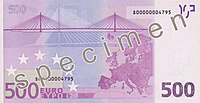| (Eurozone and Institutions) | |
|---|---|
| Value | 500 euros |
| Width | 160 mm |
| Height | 82 mm |
| Security features | Hologram patch with perforations, EURion constellation, watermarks, microprinting, ultraviolet ink, raised printing, security thread, matted surface, see through number, colour-changing ink, barcodes and serial number[1] |
| Material used | Cotton fiber[1] |
| Years of printing | 2002–2019[2][3] |
| Obverse | |
 | |
| Design | Window in Modern architecture[4] |
| Designer | Robert Kalina[5] |
| Design date | 3 December 1996[5] |
| Reverse | |
 | |
| Design | Cable-stayed bridge in Modern architecture and map of Europe.[4] |
| Designer | Robert Kalina[5] |
| Design date | 3 December 1996[5] |
The five-hundred-euro note (500 €) is the highest-value euro banknote; it was produced between the introduction of the euro (in its cash form) in 2002 until 2019. Since 27 April 2019, the banknote has no longer been issued by central banks in the euro area, but it continues to be legal tender and can be used as a means of payment.[6] It is one of the highest-value circulating banknotes in the world, worth around 529 USD; 3 830 CNY; 81 431 JPY; 419 GBP, or 467 CHF as of November 2024. The note is used in the 26 countries that have the euro as their sole currency, with a population of about 343 million.[7]
Initially, the high denomination notes were introduced very rapidly, so that in the first seven years (up to December 2008) there were 530 million five-hundred-euro banknotes in circulation. Subsequently, the rate of increase was radically slowed. In July 2023, there were approximately 281 million banknotes in circulation (decreased from 614 million in 2015). It is the least widely circulated denomination, accounting for 0.9% of the total number of banknotes.[8] It is the largest note, measuring 160 × 82 mm, and has a purple color scheme.[4] The five-hundred-euro banknotes depict bridges and arches/doorways in modern architecture. [4] The five-hundred-euro note contains several complex security features such as watermarks, invisible ink, holograms and microprinting that make counterfeiting very difficult.
The note is being phased out due to concerns of widespread use for illegal purposes. Most printing of new 500 € notes ceased in 2019, although existing notes will remain legal tender until further notice.
- ^ a b "ECB: Security Features". European Central Bank. ecb.int. 2002. Archived from the original on 30 August 2012. Retrieved 22 October 2011.
- ^ "Banknotes and coins production". Archived from the original on 18 May 2016. Retrieved 5 May 2016.
- ^ Olivier. (2019, October 6). The end of the 500 euro banknote for January 2019 the end of the 500 euro banknote for January 2019 - numismag https://numismag.com. Numismag. Retrieved October 31, 2022, from https://numismag.com/en/2019/01/06/the-end-of-the-500-euro-banknote-for-january-2019/
- ^ a b c d "ECB: Banknotes". European Central Bank. 2002. Retrieved 13 October 2011.
- ^ a b c d "Banknotes design". ECB.int. European Central Bank. February 1996. Archived from the original on 10 May 2013. Retrieved 13 October 2011.
- ^ "Banknotes". European Central Bank. Retrieved 20 January 2019.
- ^ * "Andorran Euro Coins". Eurocoins.co.uk. 2003. Archived from the original on 16 August 2012. Retrieved 15 October 2011.
- "By UNMIK administration direction 1999/2". Unmikonline.org. 4 October 1999. Archived from the original on 7 June 2011. Retrieved 30 May 2010.
- Monetary Agreement between the Government of the French Republic, on behalf of the European Community, and the Government of His Serene Highness the Prince of Monaco. No longer in force, Date of end of validity: 01/12/2011
- Monetary Agreement between the Italian Republic, on behalf of the European Community, and the Republic of San Marino. No longer in force, Date of end of validity: 31/08/2012; Repealed by 22012A0426(01).
- Monetary Agreement between the Italian Republic, on behalf of the European Community, and the Vatican City State and, on its behalf, the Holy See. No longer in force, Date of end of validity: 31/12/2009; Repealed by 22010A0204(01).
- "ECB: Map of euro area 1999 – 2011". ECB. ecb.int. 1 January 2011. Retrieved 27 October 2011.
- "Total population as of 1 January". Epp.eurostat.ec.europa.eu. 11 March 2011. Archived from the original on 20 July 2011. Retrieved 17 July 2011.
- ^ "ECB Statistical Data Warehouse,Reports>ECB/Eurosystem policy>Banknotes and coins statistics>1.Euro banknotes>1.1 Quantities". ECB. European Central Bank.